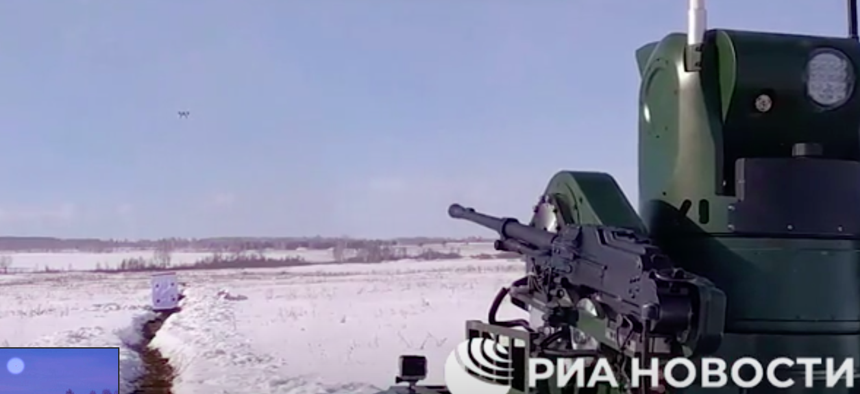
A Russian manufacturer says it is adapting one of its ground robots to target Abrams and Leopard tanks—the types heading to Ukraine from the United States, Germany, Poland and other countries.
Dmitry Rogozin, a former head of of the Russian space corporation Roscosmos and current head of the “Royal Wolves” group, which advises the Russian government, took to Telegram on Wednesday to announce that his group was working with the Advanced Research Foundation and a company called Android Technology to develop a combat version of Android’s Marker ground reconnaissance robot.
“Everyone agrees that our strike [version] of the Marker, before the arrival of the Abrams and Leopards in Ukraine, should be prepared for their destruction,” Rogozin posted.
In an interview published by Russian news site RIA Novosti, Rogozin said the Marker would “be able to automatically detect and hit the ‘Abrams’, ‘Leopard’ and other vehicles due to the electronic catalog in the control system with images of enemy equipment.”
In 2018, Android made headlines with a claim that it would put a robotic cosmonaut named FEDOR onto the International Space Station. That hasn’t happened.
Russia is unlikely to field ground combat robots to Ukraine in large numbers, said Sam Bendett, an adjunct senior fellow at the Center for a New American Security and an adviser at the CNA Corporation.
“It appears that most of the existing Markers, 3 out of 5, will in fact be tested in Ukraine, and can be lost in combat,” Bendett said via email. “It also appears that Android Technology is actually ok with that, indicating a willingness to respond to the [Ministry of Defense] needs for improved weapons and tactics, and perhaps indicating that the company is working on other projects that can build on the Marker experience.”
How well would a Russian robot perform against a well-trained human tank crew? On Twitter, Bendett expressed skepticism, calling the announcement mostly a PR stunt.
“Previous Marker tests – at least those made public – were against small UAVs, and these [unmanned ground vehicles, or UGVs] conducted tests for orienting in a complex space like a forest, but not an actual battlefield where multiple countermeasures are trying to destroy the vehicle. Moreover, Western tanks will be part of combined arms formations with aerial support like drones and UAVs, which are going to hunt for any Russian target, including the likes of Marker ground vehicles. Rogozin’s earlier claims of Marker as a recon UGV were more realistic.”
UGV makers, like most Russian technology firms, are somewhat hampered by Western efforts to stop the flow of computer components to Russia. But these sanctions have had uneven effects, according to a report out this week from the Silverado Policy Accelerator.
Android’s CEO Evgeny Dudorov said last month that technology sanctions have had little impact on his company’s ability to score key component parts, according to Bendett.
“Dudorov thinks that investments from the Russian Ministry of Industry and Trade will allow the domestic robotics industry to catch up with the leading players in about 1.5-2 years, and fully align with the market leaders in 10-12 years,” he said.
Bendett called Dudorov’s assessment “optimistic” given “the continued reliance of the Russian high-tech sector on imported components. Dudorov’s FEDOR robot was in fact almost 80% made from imported parts.”
